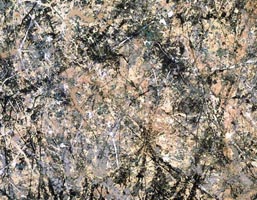|
|
Pollock (2000) from Johnny Web (Uncle Scoopy; Greg Wroblewski) |
| This film was a labor of love for
Ed Harris, and represented virtually a one-man project.
He originally commissioned the screenplay, produced,
directed, and starred in the film. It is the story of the American painter Jackson Pollock, considered by many to be the most influential American painter of the 20th century, from the time that he met his wife in 1941 (fellow painter Lee Krasner) to the fatal drunken driving accident that ended his life in 1956 at age 44. |
|
|
| Harris obviously has a great passion for
this subject, and his enthusiasm is matched with a close
physical and spiritual resemblance to the great Abstract
Expressionist that allows him to use his own natural
haunted look to duplicate the manic-depressive
fluctuations in Pollocks's character. Harris seems
perfect to me in this role. Pollock wasn't an effete
intellectual, but a masculine guy from Wyoming, a high
school dropout who loved his cigarettes and booze, and a
cold Schlitz. His paintings created themselves when he
had his bursts of manic energy, and Pollock contended
that he just opened up his mind and let them come out.
Someone once told him that even abstract art had to be
abstracted from something in nature, to which he
responded "I am nature". The combination of
intense artist with everyday square-jawed guy next door
is a role ideally suited for Harris, and Harris completed
the illusion by acquiring thirty pounds and a beard to
play the artist in the later stages of his life. Harris is also brilliant at recreating the various Pollock techniques. The camera shows him painting with both brush strokes and the drip method, and you would swear that he was creating the actual Pollock paintings. I assume Harris isn't a great painter, so he must have done some great acting and a lot of homework. The film is focused on the artistic process, and the details of Pollock's relationships with people are much less important than his relationship with his canvases. Although Pollock was a complex and protean man, his dominant behavior pattern was that of a loner and an introvert, who reached inside his own subconscious for inspiration. In the film, Pollock stares at a canvas for what seems like days, then bursts in action like Johnny Storm yelling "flame on!", and runs around the canvas like a man possessed, casting great gobs of color here and there with a logic comprehensible only to himself. He didn't speak much to outsiders. His wife Lee acted as his surrogate mother, nanny, secretary, apologist and muse. Pollock was an alcoholic who really needed Lee to help him with life's details as well as to keep him focused on his work. Unfortunately, an artistic process as internalized, as devoid of people and places as Pollock's was, doesn't always make for great entertainment. Whether you like the film or not depends on what you would like the film to be.
Some of my favorite details from the film:
|
||||||
|
 |
Jackson Pollock's "Lavender Mist" |
||||
|
||||||

Return to the Movie House home page